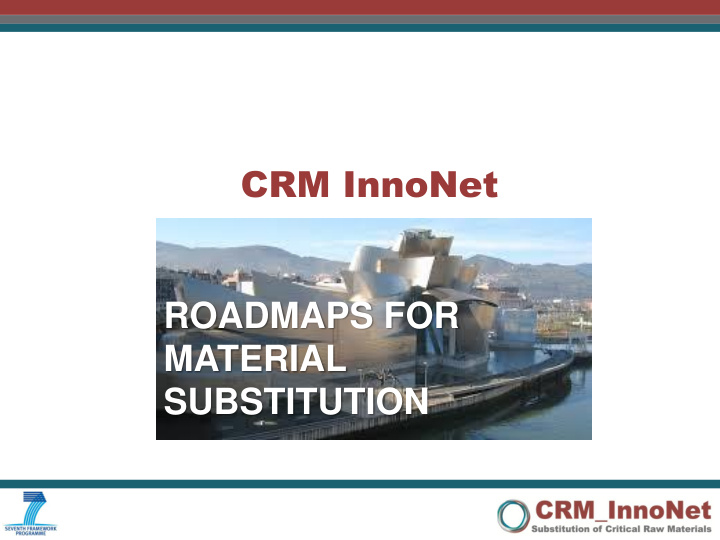



CRM InnoNet ROADMAPS FOR MATERIAL SUBSTITUTION
CRM InnoNet – the way to roadmapping • Review of criticality WP 3 • CRM for energy, ICT and transport WP 4 • 5 Priority WP 2 applications 5 Roadmaps
CRM InnoNet Roadmaps – the process Roadmapping Vision workshops On-line survey Expert selection Definition of scope (system boundaries)
Our experts • 49% industry – 51% academia Number of Workshop experts Printed Circuit Boards and 16 electronic components Permanent Magnet based 17 applications Advanced accumulators and 9 batteries 16 High-value alloys Photonics – high-end optics 10 68 TOTAL
a. Slowing demand from the aerospace industry until 2030 will ease the pressure on the markets of critical materials
Roadmapping and transition theory Landscape: centralized electricity grid Regime: penetration of renewables, energy efficiency measures Niche: local networks, self- consumption
CRM InnoNet Roadmaps – the not yet final picture 2015 2030 Landscape Drivers Barriers Trends Trend-breaks Regime Markets Policies Research Niches Societal trends Ideas I1 Weak signals
CRM InnoNet Vision Workshop - High-value alloys Source: Jean-Pierre Birat, ESTEP
First conclusions from Vision Workshop • We have overseen: design for substitution • Market response is defining what is critical • Timeline for 2030 is short • Reindustrialisation: lower costs of wages in Europe • Impact: Cost-versus performance • Common European policies, not just national. • Policy: Environmental standards for imported materials/products needed • Many examples of substance for substance and process for process research in Europe • Long term research money • Need for well educated engineers (process metallurgy, hydrometallurgy, mining) • EU and national governments should focus on industrial projects in research and education. • Cooperation between industry to share costs/risk of research to be competitive against China. • Future alloys: FeAl , intermetallics…. • 3D manufacturing to save material and new applications
CRM InnoNet Vision Workshop Permanent magnet based applications
First conclusions from Vision Workshop • Visions for 2030 – More closed loops in material flows (e.g. by recycling or by new business models (leasing instead of selling) – Better understanding of which materials are used in which products – New materials for permanent magnets will become commercially available – Development of mining for REE – Better design or the suitability of a design for a given application – Move away from REE – But CRM will have a place, but in smaller applications (lighter products due to batteries with higher power density) – Recycling has to become better (permanent magnet based coolings , cars…) – Permanent magnets will not be replaced! – People who are “using” materials have to work closer with people who “understand” the materials in order to maximize outcome or to find alternatives for REM
CRM InnoNet Vision Workshop • Printed Circuit Boards
Printed Circuit Boards Currently about 90 % of the production in Asia/Pacific Market and product expectations: • Embedded components e.g. in carbon fibre • Flexible electronics • In home monitoring • Safety & Security • Manufacturing 3.0 • PCB higher temperature resistant • Privacy related technology Key drivers for substitution • Where recycling & reuse are not the option – e.g., miniaturisation and embedded in different materials • Performance main driver but varies based on specifics of the application e.g. GaN ’wrong way substitution’ • Availability of CRM R&D funding to address gaps – types of ways to fund substitution Collaboration
CRM InnoNet Vision Workshop • Photonics
First conclusions from Vision Workshop Policy By 2030 CRM’s are well understood allowing for informed substitution decision making - government and industry supported. Recycling / reuse - product and service European (EU) body on CRMs – substitution focus Europe is key player on CRMs in the world Markets & companies Production in Europe – across the entire value chain Venture capital = new ventures Strong photonics industry voice on CRM Research Aligned with the needs of industry, acting with policy Disruptive innovation in new materials and processes = substitution
CRM InnoNet Vision Workshop • Batteries and accumulators
First conclusions from Vision ision Wor orkshop kshop • Main driving substitution force is maintaining EU security (availability, jobs, costs…) with respect to energy supply and energy technologies…. But restrains are the threats on competitiveness of solutions • Lots of good will is present, but little actual implementation in policies… although regulatory tools could evolve to be more material focus (e.g. recycling) • Industry effort is limited by long term horizon and cost issue, but demand (e.g. labelling) could drive the efforts • Due to numerous energy storage technologies, technology substitution is more likely than material substitution • Lots of new battery applications (robots, health, sensors…) could drive new needs and development
Break-out sessions – your input needed! Landscape: Which are the trends influencing the demand for Landscape CRMs, which are beyond the control of single actors? Regime: what are relevant policy and regulatory initiatives or Regime industrial substitution strategies for these applications? Niche: do we perceive ideas, social trends or emerging technologies, which could impact the regime or landscape level in the medium and Niches long term?
Recommend
More recommend